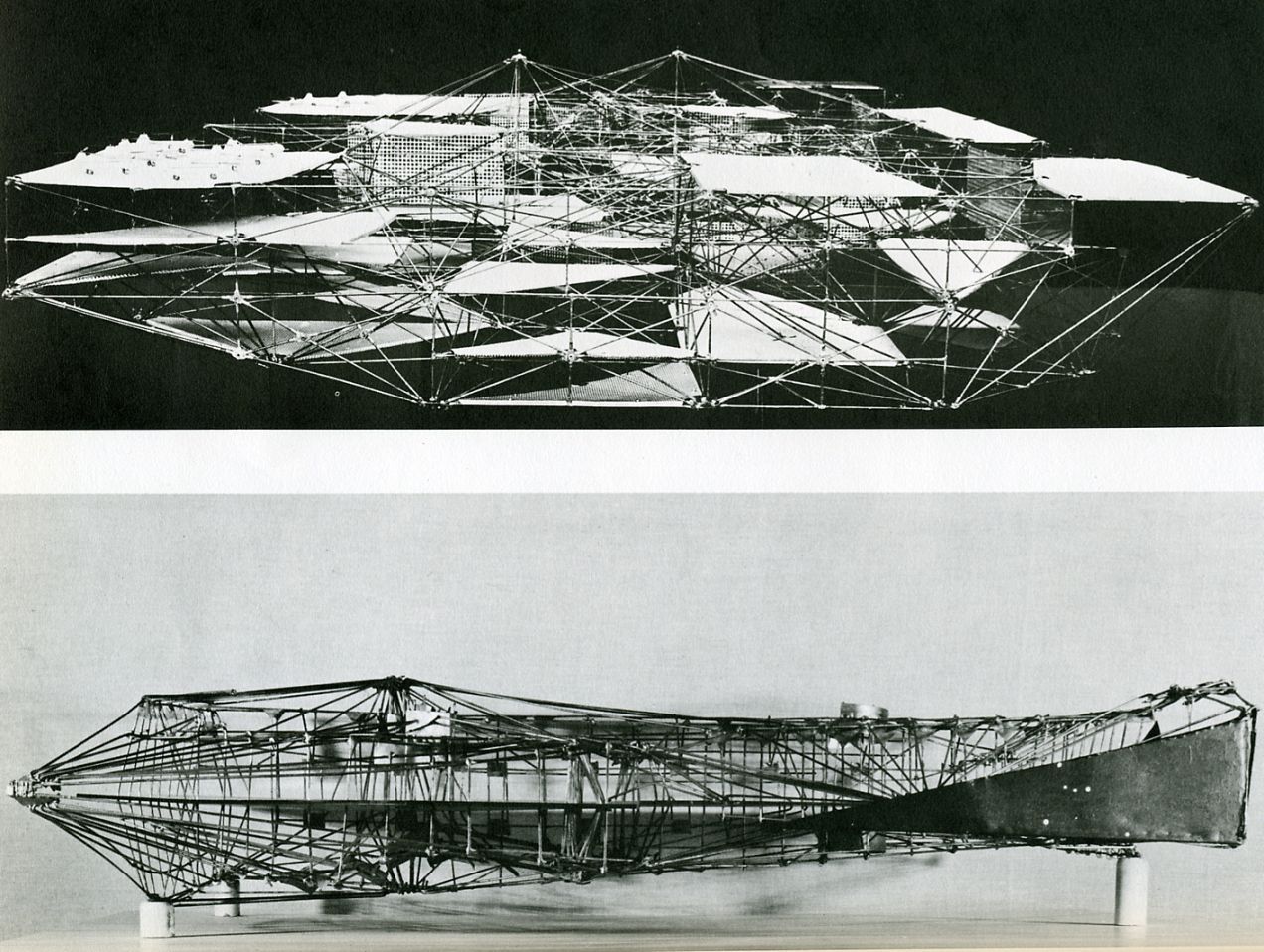Abstract
This essay elaborates on historic and contemporary case studies of experimental game mechanics applied within the field of arts, that can be consequently identified as viable methods of research in the field of social interaction. Humanities and arts draw insights on experiments based on game mechanics. Practices of role-play starting with the beginning of experiments in modern physics will be analysed herein and compared to contemporary arts and games practices.
Strategies of artistic avant-grades lead to contemporary models of networked forms of playful research practice considering installations as experimental systems in order to generate artistic artefacts as epistemic objects.
This inquiry draws on ideas of a participative research method applied in the study of playfulness as introduced in anthropologies and ethnologies. The concepts of a Ludic Society (Constant 1958 and The Ludic Society 2006 - 2016) serve as evidence for this form of participatory research in the arts, about game mechanics and social games, about the systemic power of academic writing and the necessity of membership in arts and research associations, that enables one to publish peer-reviewed writings. As a critical playful society is central to developing creative research, these examples not only provide conclusions on research methods and arts strategies, but also on possibilities of interventions to the society as a whole.
The essay’s aim is to provide a theoretical framework for the analysis of play as process in arts-based research experiments. Secondly, it questions the power of canonical writing versus poetic and automatic writing as tools of inquiry in arts and design research.
The war of methods and disciplines: Deep Play as strategy and method in research
Drawing from the systemic distinction of games and play, this essay connects very distinct fields, methodologies, theories, practices and discourses from arts, technologies, critical theory, cultural studies, anthropologies and political philosophy. The analysis of methods used in this new field of research – in between game design, arts and academia – comprise literature survey, discourse analysis and critical reflection of case studies, as found in the author’s own arts practice. It always culminates in an arts experiment as a setup to collect metadata, operated and designed by an active and participating artist. A problem this kind of participatory arts research practices poses, is the lack of critical distance, traditionally required from accepted research methodologies.
Although the convergence of evidence and analysis is highly criticised in the arts research field, it is not new in humanities. Newer methods in anthropologies can be named here:
These methods can be found in the reflections upon a playfulness discourse in three distinct disciplines: systems theory, games studies, and anthropology. From the viewpoint of these fields, the potential of the research efficacy of play in social systems and in arts research is discussed, and a pattern of problems of arts and design research is synthesised, drawing on anthropological play theories.
Deep Play (Geertz 1973) was applied, as a particular methodological objectification from the broader context of anthropologies. It builds on the mutual information of investigating subject and research object. The social analysis method of “thick description”1 was introduced with a case study of Balinese cockfighting as a particular play practice with high social impact. An analysis of an immersive betting game shows how social hierarchies are embodied by play. This also inherently identifies how to ask and frame research questions of playfulness. Geert observes and tries to understand the players, who bet on fighting cocks and gain or lose social reputation, money, and credibility. By doing so, he causes a conceptual migration of the social structure, as observed in his social reputation system. He participates involuntarily in the social hierarchy game.
The term “Deep Play” is a wordplay, informed by interpretations of the effects of betting and winning on social status, and how the player’s social hierarchy deeply incorporates a play result. As Geert reminds us, play is experienced as embodied social relations. However, in terms of playful methodology this intervention emphasises play using the method of “thick description. By definition, “thick description” is a very dense view of certain actions, close to an incorporation of the matter investigated. Such research coinages play with the immersion of investigated research subjects and research hierarchies. It describes the dense involvement of the researcher in the phenomenon investigated, which results in the accuracy of the terminology developed in a discipline.
The participatory method of Deep Play synthesises a contemporary critical narrative of an emerging form of Ludics_,_ a term I have elaborated on previously in Ludics for a Ludic Society (Jahrmann 2011). Its particular research methodologies support the processes of subversive agency in research in relation to technologies, suggested through arts practice.
This essay identifies art practice as a discrete field of research, and thus introduces arts-informed methods of research. It analyses categories of conceived, perceived, and lived agency, which support a methodological framework of the mutual information of theory and practice. It interprets Ludic art works as experiments, which test the hypothesis (of play), formulated as art, but appearing as a method of research. Each interactive art piece and its inherent game mechanics can be described according to the research question objectives and test various hypotheses of agency. Such evidences consequently support a theoretical interpretation to each artwork’s description. Art pieces, in particular interactive installations, can be used in conjunction with theoretical writing to more fully understand the nature of the works and their reception as theoretical and practical intervention. If we consider a socially informed meta-level of playfulness as framework, it is important to notice that play has epistemic effects outside playfulness as reference.
Playfulness can be understood as a model for research situations, because as a framework it addresses what Goffman (1974) described as the need to “transform serious, real action into something playful” and to gain new insights through this transformation. The transformation of play from a cultural practice to a practice of insight with significant consequences for real life and social relations, contradicts the irrelevance/relevance dichotomy, which is attributed to play in certain general assumptions. Instead, the anthropological view on play strengthens an understanding of differentiated levels of social efficaciousness.
The conclusion of this understanding on a suggested form of playful research in arts, which would be perceived as an oxymoron in established discourses of sciences, can function in the arts world with its own inherent logics. Electronic arts instead provides the primary evidence for research output. Research as participatory process reverberates on the method, which emerges from the synthesis of theory and practice in arts. In addition, the logical consequence suggests a methodological framework of arts research. Ludic as a method works within this framework of arts through the integration of anthropological concepts of play, agency, pleasure and enjoyment in relation to practical examples of subtle forces in the play with machines. It reflects on the new methodological solution in the inter-play with machine systems and its potentials for theory, social design, and arts practice, in relation to technological materiality.
Ludics can be understood as a new concept, in which philosophy and art practice converge. The practice-led research aims to offer a model of playfulness, which overcomes the lack of agency, pleasure and material consciousness in relation to play and technologies. With a survey of the dominant understanding of playfulness in the current electronic culture, this theory of an arts based research has its roots in subversive practices of play through the political activism of everyday life. Through historic and theoretical analysis it subjects this understanding of playfulness relative to:
- A critical assessment of playfulness in historic and contemporary theories and its synthesis as a particular dimension of social research agency.
- Ubiquitous play as condition of technological social networks, based on recent evidences and examples of contemporary activist arts.
- Political subversion and research synthesis in cases of role-play in relation to technologies as precedents of the contemporary play with the self in social media. Arts experiments, which show the power of playfulness as epistemic strategy, when it is synthesised with theoretical concepts for a new understanding of everyday life and technologies.
- Case studies of artworks that contribute to the emergence of a new methodology of playful insights, which can be coined for each art practice individually, but culminate in the case of games and interactive arts, as Ludics.
This trajectory for research methods in the arts is formed through an intervention between both practical approach and sophisticated understanding of playfulness, which when situated at the edge of art and games, deploy the possibilities of interconnection, interaction, and subversion that certain technologies inherently allow. Therein, by means of art, such a research practice inverts the culturally received order of efficacy against playfulness. This argument is extensively informed by the author’s own practice over the last decade, questioning the achievements of this practice in relation to its intentions to reveal deficits as well as insights for research by arts. Such a form of research is stimulated by practice-led research and theoretical reflection. The concept and practice of playfulness can support the development of a sophisticated model for arts informed methodologies of social analysis and research.
Throughout this analysis conceptual key terms for an artistic and participatory research method are explained. These are informed by cultural and historical studies, anthropological and political theories, the arts and technical language — resulting in arts installations as temporally and spatially limited experiments, comparable to a magic circle of play. In order to enable further analysis of the intersection of philosophy, anthropology, everyday life, the art system allows the artist researcher to collect metadata of reception situations. This method of research in the arts draws on principles of game mechanics as experimental systems. As a synthesis of practice and theory, the concept of Ludics appears as an emerging research methodology that includes a potential for new critical art works. Although it still draws on separate disciplines, it intrinsically integrates the arts practice as knowledge practice, oscillating between practical theory and theoretical practice. The playful Ludic method subverts the ideological complicity of technologies and user control through philosophy and arts.
Experimental systems and their game mechanics
Conceptual basics of applied game design can clarify what is understood by the term “game mechanics”. Game mechanics principles and the merit of the experience of a so called epic win gained as well as immersive flow achieved in games, can explain the fascination and expectation of the sustainable experience made in playful environments. It is crucial that both aspects of games, the free play and the rule determined game mechanics, support these emotional ties to a game. Therefore, contexts that are not games can gain from a playful systematic. Gasification exploits the long-known persuasive rhetoric of play. A Ludic method can still identify the qualities of game mechanics, but goes beyond play in terms of critical reflections as required for research issues.
The game-studies scholar Brian Sutton-Smith (1997) already discussed this concept. He highlights the psychology dimension of play as a creative learning process in terms of the development of an individual’s values. He argues that play contains a dimension, which provides a form of mental feedback that reinforces creativity. Supported by a respectable developmental psychology study of play, he presents a seminal theory on the ambiguity of play as rhetoric of emotional survival. Consequently, he describes play as a constitutive element of such cultural realms, which facilitate techniques of psychological stress management, which the investigation of social experiments would usually require. In our context of the analysis of strategies in arts and research this understanding of play identifies game mechanics as ideal vehicle to analyse and research social process, social design and urban planning, in particular through a game mechanic, which is called role-play. Correspondingly, the role of the researcher can be taken by artists in order to develop new forms of writing, reflection and critical distance.
The game mechanics of arts and exhibition experiments can be compared with the development of the scientific experiment in the mid-seventeenth century. The physics experiments with the vacuum, that includes the researcher as performer, serve as paradigm for this development. The public appearance and formation of the role of the researcher as performing “experimenter” facilitates the becoming of an epistemic object. This can shed light onto contemporary artist researchers and explain practices of a social arts performance, focusing on relevant questions of society and sciences.
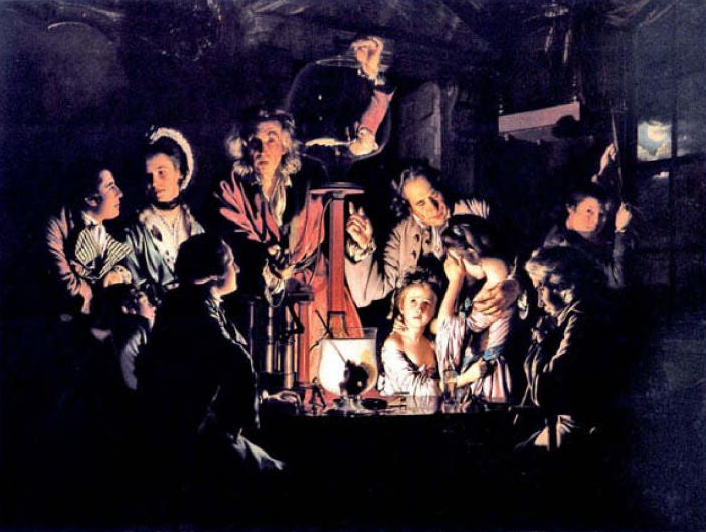
Nordmann (2011) uses the painting A philosopher shewing an experiment on the air-pump (1769) to illustrate the spectacle of a private soirée around the technological instrument of the air-pump. The publicly performed experiment showed that incredible void, nothingness, exists in the glass tube over a mercury barometer, from which the air is pumped out. The performance spectacle of a quasi home laboratory demonstrating this is deadly, at least for singing birds and candles inside the glass tube. “Horror vac” is no longer understood as a pure term of the arts, as it was expressed in excessively decorative graphical patterns since the Alhambra, but, rather as an experience made through sciences. Interestingly the emptiness, the void space served as starting point for the physical experiments, that led to the failure of Aristotelian nature philosophy, showing there can be no absolute void in nature. Similarly the vacuum marked an experimental method principle as the white clean room of the exhibition space in arts led to a new understanding of arts research. In fact this spectacle of the experiment experienced as playful entertainment can be identified as game mechanics of the experiment as public performance. The situation of public demonstration shades to requirements of the Society of the Spectacle, as later in the 20th century Guy Debord (1958) expressed it in relation to media as a contemporary arts method.
Game Mechanics and critical writing as research method of Situationists
The Situationists understood play as a method to reorder and establish social and economic relations and to evaluate new systems of thought. A political social utopia was outlined, in which aesthetics and arts were considered as the main vehicles of the creation of society. This aesthetic realm was expected to support the evolvement of a political field and society in play. Foremost Guy Debord theoretically expressed a particular activist definition of play as research method in his essay A Situationist Definition of Play. In the magazine Internationale Situationniste #1, play was radically introduced as method and vehicle in order to research, analyse and reclaim urban spaces.
The corresponding arts experiments were social walking experiments in urban space. Game mechanics of walking by rules, as following specific “play maps” were applied as vehicles of investigation. Then the reflections, comparable to the qualitative analysis of a research experiment, followed in Situationist writing. Such texts described the city of the future as a site of total mechanisation; in which the need to work is replaced with forms of a nomadic creative play. Its aim was to appropriate hegemonic power and to overcome social restrictions of love and life by free time and space – through the analysis and participative research method of play.
In the context of arts strategies and game mechanics interpreted as research method, the role-play as creative Homo Ludens becomes of seminal interest. The Dutch artist Constant Nieuwenhuys suggested a playful social interaction and creativity model, enabled by technologies. He spoke about the invention of a ludic society, liberated by mechanisation from the domination of time and labour, which is redeemed by mechanisation. In the magazine Potlatch (1959), Nieuwenhuys positioned his idea of a mechanically liberated Homo Ludens:
The creative man, Homo Ludens, can only claim his rights on rare occasions. The opposite of utilitarian society is ludic society, where the human being, freed by automation from productive work, is at least in a position to develop his creativity. (…) He learns by playing. (…) Such play is possible due to the integral technical control of all those elements, which thus become a conscious creation of the environment. (Nieuwenhuys 1959)
(1974)
Play process, game systems and poetic writing
Homo Ludens by Johan Huizinga (1938) analyses the process of play as cultural agens (Latin: acting) as synonym for agency, as required in cultural experiments. The title, Homo Ludens. A study of the Play Element in Culture refers to an understanding of play as a driving force for cultural achievements. This leads to discussions about play as a practical source of human culture. A notion of this kind emphasises the dimension of play as inevitable energy for creative processes and cultural systems. As a consequence, Homo Ludens became one of the most important books for the evolving discipline of games studies, but in the reading of the text, the focus was shifted towards an understanding of games as a necessary frame for play. Contrary to this understanding, Huizinga originally expressed the understanding of play as a source of all culture in an appealingly radical manner. This condition was frequently overlooked in its relevance for the recognition of the role of the process of play in arts research.
This view is informed by a capitalist understanding of society, in which work is opposed to play. Homo Ludens is described in opposition to Homo Faber, working man, which indicates that play and game are clearly differentiated from one another by the phenomenological division of functions. Nowadays, in a society defined by technological play, work time and playtime disperse. This development was anticipated in an understanding of the cultural relation of man, play and games. In a similar way, the French social scientist and novelist Roger Callous (1913-1978) discusses the cultural relation of man and play in his book Les Jeux et Les Hommes (1958) by introducing categories of players. He is recognised as a significant author in games studies for this categorisation. Considering how his categorisation circles around the phenomenological player, he can also be identified as particularly significant in the context of the analysis of playfulness as research principles. His writing supports the introduction of the topic of playfulness as a contemporary category of research and insight. In addition, in this analysis it is important to take into consideration that Callous was a poet, surrealist and member of the prestigious Académie Française. His role as researcher and as renowned poet, who embeds his theories in his poetic writing, allows us to draw parallels from his writing as examples of arts as research.
Comparably the Ludic Society magazines 3 that I have edited since 2006, can be understood as being informed by Situationist principles of a researching Homo Ludens, who edits, writes and designs art experiments through the appliance of interaction principles found in game mechanics; in short research as art form based on play.
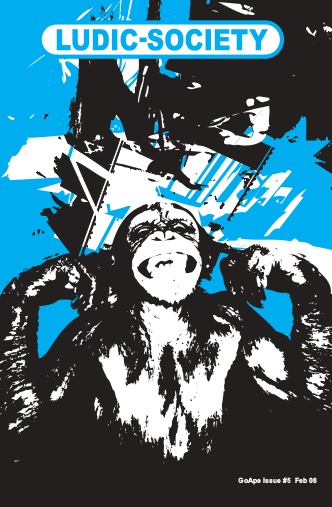
Research game mechanics of role-play in Neoist manifestos
A particular form of writing by fictional role-play figures as part of interventionist arts practice was developed in Neoism 4 as described by the Neoist fictional figure Cantsin (1984). Nest activists performed role-plays and used the technologies of publishing media for political aims. Neoism emerged out of ink culture in the 1980s. As social networkers the Neoists applied means as performances and role-playing, as well as publishing under alter egos. Cantsin reports:
In the performance of Neoism actual performance pieces play an important role because in Neoism we have chosen to perform a late twentieth century movement whose precursors are Situations and Fluxes, it logically follows that the artistic substance of Neoism will be performance and text, especially manifestos, rather than painting which characterises nineteenth century art movements.
(1984)
These manifestos, which were published as fanzines and in subcultural networks played an important role in making these fictional identities public. Role-playing and alter egos are seen here as popular culture practices in creating identities. The magazine SMILE, for example, was published as part of a Neoist manifesto. Cantsin, a fictional name, is mentioned as publisher of this manifesto:
The Neoist projects desires onto herself. She defines identity through never specified business. Her desire is commoditised. In her longing for man-woman-machine-hybrids, wish machines, she destroys her property and ends up in self-containment.
(1984)
Serious research, flavoured by playful practices, enjoyment and irony are identified in a writing game mechanics of interventions in Neoism. Its fictional intent is to describe how societies in general, and identity in particular, are constructed by desire and enjoyment — and to publish all this through a new form of poetic writing: automatic writing as participatory research strategy, informed by the arts.
Case study of performance role-play as arts research experiment
Today, forms of Neoist role-play, where the artist identifies him or herself as researcher, can occur more often. The following evidence will display how role-playing, as an avant-garde arts practice, allows the development of a research argument on the participatory imperative of contemporary social networks. A new agenda of performance as tool of agency is expressed by poetic texts, drawing on the attraction of the machine and the electronic network as latest apparatuses of control. Through the participatory re-use of the commercially shaped materiality of technologies, parallels can be detected to an almost forgotten self-determined craftsmanship, which dives through in the hybrid practices of play and arts with technological objects and networks. The resulting attitude can serve as role-model for the playful artist-researcher.
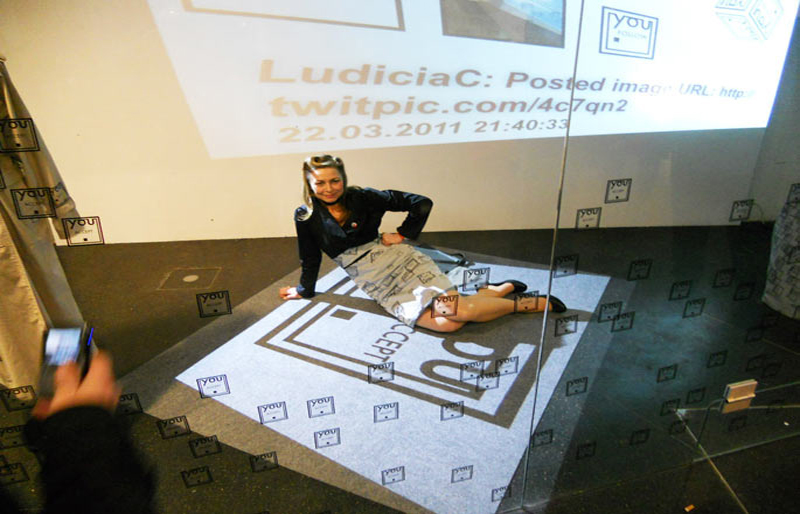
The installation game AAA profiler provided a research experiment about user behaviour. The game art-piece combined a physical role-play performance with coded fabrics, live photos, alternate reality codes and images with text drawn from Twitter. In a live projection in the installation and on a website the images were fed back into Twitter, in order to produce subliminal messages. These couplings follow the Situationist’s strategy of cutting up elements of mass media and combining them in new ways in order to reflect the manipulative functions of media, advertising and user manipulation. Particular interfaces had been especially designed and developed for the purpose of the exhibition. The aim was that the interfaces would work as digital codes thus triggering the camera eye of a computer but also being readable by human eyes.
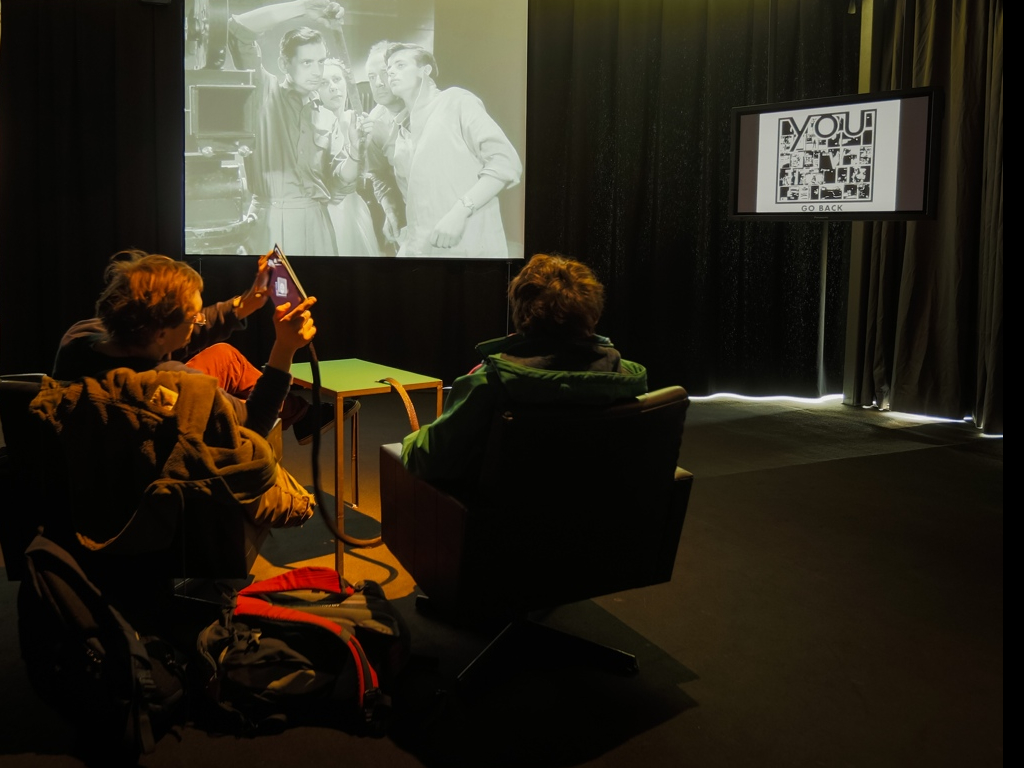
It was essential to analyse the metadata of the user behaviour in order to develop a research exhibition interface for a research project on alternate reality and natural markers. It aimed on the arts experiment and to finally stage knowledge found during a three year research process in a major exhibition, in order to evaluate the research findings. Valuable data of visitors and qualitative analysis of play behaviour could be reported as outcomes. The results were partly published in the book Play and Prosume (Felderer and Jahrmann 2013).
Conclusion
Artworks embracing public but clearly defined and marked experimental set ups, including elements of creative writing and role-play are key in understanding the method of applied game mechanics for research. This conclusion considers an idea of participatory role-play for research aims. It draws from a popular orientation of game design, also towards a critical dimension of popular play in social media network technologies. This angle allows to draw parallels to the contemporary technologically enhanced play as paradigm for new forms of participatory experiments, in order to generate metadata about users, players, researchers and research methods. Corresponding with the observations of political role-play in activism, it applies the subtle enjoyments of play with the self as a form of arts research.
A new methodological framework of practice based research can evolve out of the entanglements of politics and pleasure in the practices of the contemporary 21st century Ludic Societies. The play component of present-day smart objects requires to take the role of a playful “interact”, which means the contemporary parlour is identified everywhere in the world of ubiquitous computing games. The attraction of roleplaying in contemporary parlour games addresses both – the object and subject of humanities and arts research. Ludic as method addresses the playful spheres of electronics, as well as live role-playing, as a symmetrical tool of the arts and critical research, informed by game-design principles and game mechanics ideas.
From these examples of arts and play research experiments, it can be seen, that the trajectory goes from a concept of entangled playfulness and enjoyment to the more subversive interpretation of activist role-playing as conscious research subject. The inquiry demonstrates that the concepts are, particularly in research and arts strategies, communicated in individual role-playing, which include Ludics methods as a means to an end-research.
- Felderer, Brigitte, and Margarete Jahrmann, eds. 2013. “Play and Prosume: Technology, Exchange and Flow.” Verlag für moderne Kunst.
- Cantsin, Monty, ed. 1984. “First Manifesto of Neoist Performance and the Performance of Neoism.” SMILE, no. 6.
- Caillois, Roger. 1958. Les Jeux Et Les Hommes: Le Masque Et Le Vertige. Gallimard.
- Debord, Guy. 1958. “Contribution to a Situationist Definition of Play.” Translated by Reuben Keehan. Internationale Situationniste 1. http://www.cddc.vt.edu/sionline/si/play.html.
- Geertz, Clifford. 1973. “Deep Play: Notes on the Balinese Cockfight.” In The Interpretation of Cultures, 412–55. Basic Books.
- Goffman, Erving. 1974. Frame Analysis: an Essay on the Organization of Experience. Harper & Row.
- Huizinga, Johan. 1938. Homo Ludens. Versuch Einer Bestimmung Des Spielelements in Der Kultur. Rowohlt.
- Jahrmann, Margarete. 2011. “Ludics for a Ludic Society. The Art and Politics of Play.” University of Plymouth. http://hdl.handle.net/10026.1/453.
- Nieuwenhuys, Constant. 1974. New Babylon: A Nomadic Town. Exhibition Catalogue. Haags Gemeetenmuseum.
- ———. 1959. “The Great Game to Come.” Potlatch The information bulletin of the Situationist International (30): 6.
- Nordmann, Alfred. 2011. “Aufstieg Und Fall Des Nichts: Gewalt, Fremdheit, Verheißung Der Experimentalwissenschaft.” In Philosophie in Experimenten : Versuche Explorativen Denkens, edited by Gerhard Gamm and Jens Kertscher. transcript.
- Sutton-Smith, Brian. 1997. The Ambiguity of Play. Harvard University Press.
-
Geertz compares the method of thick description of an interpretive anthropologist, who accepts a semiotic view of culture, with the method of the literary critique when analysing a text: “Analysis, then, is sorting out the structures of signification—what Ryle called established codes—and determining their social ground or import.” (Geertz 1973) ↩
-
The image New Babylon construcities (Nieuwenhuys 1958) was retrieved online from Strabrecht College. ↩
-
Please refer to http://www.ludic-society.net ↩
-
Compare Anthologies of Neoism, as shown on this repository, guerrilla Playfare: unusual interactions and/or interventions in environments where such incidents are unexpected - see #s 39, 40, 41, 43, 44, 49, 50 - 53, 55, 57, 59, 63, 65, 66, 67, 99, 103, 108, 109, 113, 114, 135, 142, 143. (Cantsin 1984). ↩
